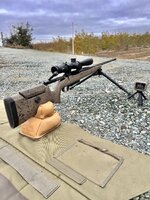I have had multiple people ask me to lay out how I do load development being that what I do is different. Since Shaen
@Shooter71 just rebarreled a Tikka 595 in 6XC I thought it would be easy to show how I do it. It’s a Master Sporter with a T3 lite profiled 20” barrel- keep in mind it is a T3 LITE barrel. So by conventional “wisdom” it should be more picky and less accurate than a heavy barrel. His work is shoddy (

), but I bet I can overcome it.
The rifle-
View attachment 339906
First was
@Unknown Munitions factory load with 105gr Berger Hybrids. 5 rounds to zero, 5 for a “group” at 114 yards-
View attachment 339908
That’s about .7 moa for five. Slipped turret, then five rounds at 1050 yards to true on a 15” plate. First two rounds were to velocity correct, next three hit the plate. If I didn’t need to evaluate a different bullet I would have stopped, ordered 2,000 rounds from Jake and just shot. But I do need to evaluate a bullet, so…
“Load Development”
I don’t do 37 trick moves, I don’t play with seating depths in 5 thousandths, I don’t screw wirh .1 grain powder increments, I don’t try six different powder types, and three different primers, etc. I pick the bullet I want to shoot, a case, a decent primer, a near max load, and seat the bullet to fit magazines, just kiss the lands, or as in this case to seat the bullet so the boatail is at the shoulder/neck junction of the case. For this gun components are hard to find. I was able to get IMR 4166 which is good for the mid bore 6mm’s, the bullet is a 115gr DTAC with Nosering. The cases are Peterson SRP, primer is Federal 205.
I loaded one round at max charge, shot it-
View attachment 340021
Not bad, just a slight ejector mark. Dropped .5 grains, loaded twenty, went to group.
3 rounds to get on paper, then ten rounds at 114 yards for the first group-
View attachment 340032
.72 moa.
One round after slipping turrets, 6 rounds at 1050 yards for trueing. Velocity is 2,830fps.
So we’re at 15 rounds of a factory non tailored load, and 21 rounds for a “random” picked load to get sub moa for ten rounds and trued past 1,000 yards. 21 rounds and done. This is literally what I do for every rifle. Either the rifle and load shoots or it doesn’t.






